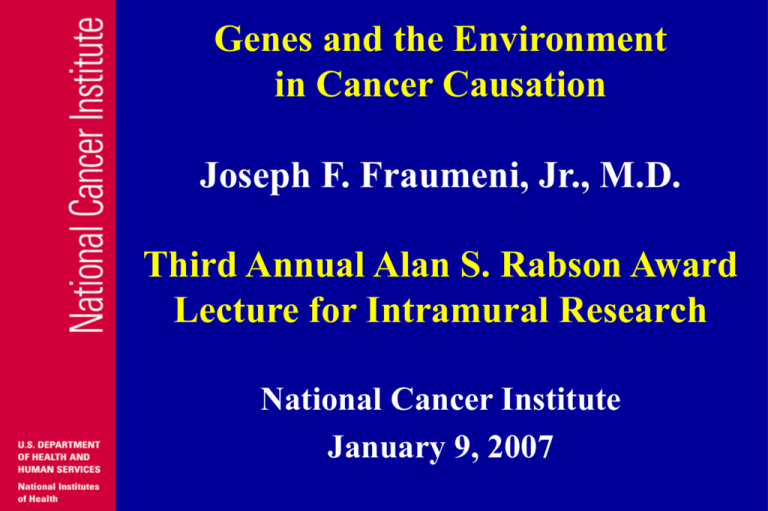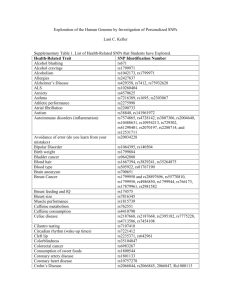BSC
advertisement

Genes and the Environment in Cancer Causation Joseph F. Fraumeni, Jr., M.D. Third Annual Alan S. Rabson Award Lecture for Intramural Research National Cancer Institute January 9, 2007 A distinguished NIH couple, Alan Rabson (Deputy Director of NCI) and Ruth Kirschstein (former Acting Director of NIH) Early Days at the National Cancer Institute Categories of Cancer Causation Genes + - Environment - + Spontaneous Microbes – 1960s Chemicals – 1970s Lifestyle – 1980s Hereditary syndromes Low-penetrant variants Interactions International Variation in Cancer Incidence Type of Cancer H/L Highest Rates Lowest Rates Melanoma 155 Australia Japan Nasopharynx Prostate 100 70 Hong Kong U.S. (Black) U.K. China Liver 50 China Canada Cervix uteri 28 Brazil Israel Stomach Lung Colon 22 19 19 Japan U.S. (Black) U.S. (White) Kuwait India India Bladder Pancreas Ovary Breast 16 11 8 7 Switzerland U.S. (Black) N.Z. (Maori) Hawaii (Hawaiian) India India Kuwait Israel (Non-Jews) Leukemia 5 Canada India RRs of Breast Cancer in Asian-American Women by Migration History 1.8 Relative Risks 1.6 1.4 1.2 1 0.8 0.6 0.4 0.2 E // 4E E // 4E E // 4E E // 4E W // 4E rural - E urban - E rural - E urban - E <8 y in W <8 y in W 8+ y in W 8+ y in W Ziegler, R. et al. JNCI 1993; 85: 1819-27 W//1-2W W//3-4W Estimated Annual Percent Increase in Cancer Incidence SEER 1992-2001 WM Liver 3.9 Melanoma 3.2 Thyroid 2.8 Kidney 1.4 Testis 1.3 NHL -0.5 Esophagus 1.9 WF BM BF 5.0 4.8 2.2 3.2 2.2 -3.4 4.8 0.8 3.8 1.4 1.9 2.8 6.4 0.8 -1.5 2.9 -0.2 -5.8 -4.1 Esophageal Cancer, 1973-1998 (Males) Rate per 100,000 Squamous Cell Carcinoma Black Males 10 Squamous Cell Carcinoma White Males Adenocarcinoma White Males 1 Adenocarcinoma Black Males 0.1 73-74 78-80 84-86 90-92 Year of Diagnosis 96-98 Copper Smelter, Montana Indoor Air Pollution in China The Causes of Cancer • • • • • • • • • Tobacco Alcohol Nutrition, including energy balance Infection and inflammation Occupational hazards Environmental pollution Pharmaceuticals, including hormones Ionizing and UV radiation Genetic susceptibility +++++ ++? +++? ++? +? +? +? +? ++??? Note: About 50% of all cancer appears related to modifiable risk factors. Alfred G. Knudson and Two-hit Model for Retinoblastoma Proc Natl Acad Sci USA 1971; 68: 820-3 Child with Congenital Aniridia Li-Fraumeni Syndrome _________________________________ • Dominantly inherited • Striking variety of early-onset tumors • Predisposition to second primaries • Germline mutations of p53 Cloned Familial Tumor Suppressor Genes Retinoblastoma RB1 13q14 1986 Wilms’ tumor WT1 11p13 1990 Li-Fraumeni syndrome p53 17p13 1990 Neurofibromatosis 1 NF1 17q11 1990 Neurofibromatosis 2 NF2 22q12 1993 von Hippel-Lindau syndrome VHL 3p25 1993 Familial melanoma 1 p16 9p21 1994 Familial breast cancer 1 BRCA1 17q21 1994 Familial breast cancer 2 BRCA2 13q12 1995 Basal cell nevus syndrome PTC 9q22 1996 Percent Cumulative Incidence Cumulative Incidence of Second Cancer After Hereditary Retinoblastoma 40 30 20 10 0 0 10 20 30 40 Survival (Years) Radiotherapy No Radiotherapy 50 Susceptibility (Modifier) Genes* Function Examples Behavior OPRMI, LEP Metabolism ALDH2, NAT2, MTHFR Hormones COMT, SRD5A2 Growth Factors IGF1, GMCSF Cell Cycle CHEK2 DNA Repair XRCC1, XRCC3 Apoptosis FAS, CASP8 Telomerase TERT, DKC1 Angiogenesis VEGF, CD14 Immune Regulation CCR5, TNF, IL8 *Role of carcinogens or anti-carcinogens may be inferred by knowing the substrate or pathway of the gene variant. Moving Toward Large-scale Studies: International Consortia • Multicenter partnerships that strategically and cost-efficiently utilize separately funded epidemiologic studies with biospecimen collections. • Cohort, case-control, and family-based consortia that maximize power of genomic and other emerging technologies. • Replication strategies: Provides rapid confirmation of positive or negative findings from independent datasets. • Pooling strategies: Combines datasets for statistical power to identify risks from gene variants, exposures, and interactions. InterLymph (18,000 Cases) International Lymphoma Epidemiology Consortium Participating Centers IL1B-511 Variant TNF G-308A Variant Rothman, et al. Lancet Oncol 2006; 7: 27-38 NCI Consortium of Cohorts Exploiting the Molecular Revolution for Cancer Discovery and Pre-emption General Strategy for Prostate & Breast Cancer Genome-wide Association Studies Initial Study 1150 cases/1150 controls 540,000 Tag SNPs Follow-up Study #1 3500 cases/3500 controls ~28,000 SNPs Follow-up Study #2 3500 cases/3500 controls at least 1,500 SNPs Fine Mapping 30 ±20 loci Epidemiology During the Molecular Revolution • Move with greater speed and force to identify genetic/environmental determinants in cancer induction and progression. • Probe into causal pathways and mechanisms as possible targets for intervention. • Foster platforms and strategies of large-scale studies, including consortial initiatives. • Encourage multidisciplinary research to galvanize discovery and translation to clinical practice and public health. DCEG Senior Advisory Group Retreat 2006 Robert Warwick Miller, M.D. 1921 – 2006





